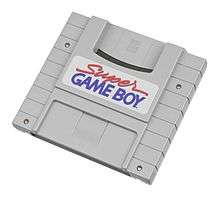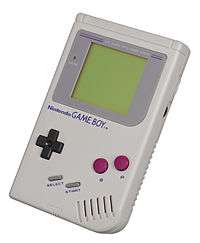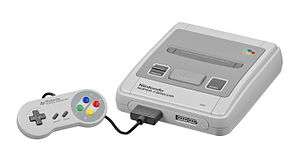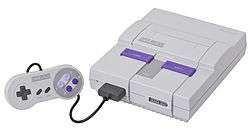Super Game Boy

The Super Game Boy (スーパーゲームボーイ Sūpā Gēmu Bōi) is a 16-bit adapter cartridge for Nintendo's Super Nintendo Entertainment System (known as the Super Famicom in Japan). It was the first Game Boy-based add-on to a Nintendo console. The Super Game Boy allows game cartridges designed for use on the Game Boy to be played on a TV display using the Super NES controllers. When it was released in June 1994, the Super Game Boy sold for $59.99 in the United States.[1] In the United Kingdom, it retailed for £49.99. It is the precursor to the Game Boy Player on the Nintendo GameCube, which functions in a similar manner.
Gameplay

The Super Game Boy is compatible with the original monochrome Game Boy cartridges, Game Boy Camera, and the black Game Boy Color cartridges although it would display the latter in their monochrome compatibility mode. The unit could map the four shades of green to various colors on the screen. Later Game Boy games that were optimized to use the Super Game Boy had additional color information and could over-ride the ability to change the on-screen colors, and the ability to display a graphical border around the screen as well as the ability to display special background sprites on the screen, as seen in the Mario's Picross title screen. Those games would have printed a small "Super Game Boy Game Pak" logo on the box and cartridge. The adaptor could support up to 64 colors for the border, and 12 colors for the screen. Static screens could display all 10 colors.
It is also possible for Super Game Boy games to make use of the Super NES hardware for extra effects, as demonstrated in Contra: The Alien Wars, Donkey Kong, Kirby's Dream Land 2, A Bug's Life, Animaniacs and Toy Story; these games had expanded sound when used with the Super Game Boy. Wario Blast, the Game Boy version of Killer Instinct, and several other titles even allowed the second Super NES controller to be used for two-player action, and the title screen changed to show that these games had a two-player option, rather than a connection status. The original Super Game Boy does not support game link multiplayer because, according to a Nintendo spokesman, a two-player configuration would interfere with the RF signal from the television.[2]
The Game Boy version of Space Invaders allowed players to access a Super NES version of the game as well as a coloured version of the Game Boy game.
Some black Game Boy Color cartridge games also have Super Game Boy enhancements, although there isn't any logo indicating this on the cartridge or on the front of the box as there are for original Game Boy releases. Several GBC titles do have a small Super Game Boy compatibility icon located on the back of their packaging, such as for Dragon Warrior Monsters 2: Cobi's Journey.[3]
Hardware
The Super Game Boy actually consists of the same hardware as the Game Boy; inside the cartridge is a separate CPU that processes the games while the Super NES only provided means for user-input, output of graphics to the screen, and the additional coloring, similar to the Atari 5200 version of the Atari 2600 adapter.
The original Super Game Boy is known to play the game program and its audio 2.4% faster than other Game Boy hardware. This is due to the use of the Super NES's clock speed divided by 5, which ends up being 4.295 MHz instead of 4.194 MHz.[4] The timing issue can be rectified by adding an appropriate crystal oscillator to the Super Game Boy and disconnecting the Super NES's clock source.[5]
Super Game Boy 2

The Super Game Boy 2 was released exclusively in Japan in 1998. Additions included a link port to allow a user to access two-player mode via the link cable, the green game link LED, and the red power LED indicator, and runs at the exact speed of the Game Boy (the original model runs 2.4% faster than a Game Boy). In addition, it came with eight new default borders, which replaced those in the original model (though the old borders are still accessible via a code); however, it retained the same built-in palettes and coloring tools as on the original model. Also, this version of the SGB does not allow one to change borders in some games that have built-in borders. Some games have features only available through the Super Game Boy 2, such as a special Tetris DX border.
System menu
The system menu is accessed by pressing the L and R buttons at the same time; the menu has five options to choose from:
- Color Palette: Choose from one of 32 pre-made color palettes, the Super Game Boy enhanced palette(s) (if available), or a user-created palette (if available). A few Super Game Boy games will not allow the palette to be changed. Internally, the Super Game Boy includes special palettes for several games that came out before the release of the Super Game Boy; for example, Alleyway, Yoshi's Cookie, Kirby's Pinball Land, Metroid II: Return of Samus, and Solar Striker have one 1 of the 32 default colors by default.
- Border: Choose from one of 9 pre-made borders, the Super Game Boy enhanced border(s) (if available), or a user-created border (if created).
- Button Setting: Switches between two controller mappings. A few Super Game Boy games will not allow the controller setting to be changed.
- Custom Color: Create a custom color palette and get a password to retrieve it later. If palette changes are disabled, this option will also be unavailable.
- Graffiti: Create a custom border by using several painting tools. If plugged into the second controller port, the Super NES Mouse could be used for this feature.[6]
Predecessors and successors
The Super Game Boy is the successor to Intelligent Systems' Wide Boy 2 (which connected to the Famicom or NES). One difference between the Wide Boy and the Super Game Boy is that the former did not use any part of the Famicom/NES other than the video memory. Even the controller (a single Famicom controller) is hardwired directly into the Wide Boy. The Wide Boy would continue running even if the reset button is held down on the Famicom/NES. The Game Boy had twice as many tiles as could fit in the Famicom/NES's video memory, so the Wide Boy had to refresh the Famicom/NES's video memory halfway down the screen.
Camerica had the Game Boy to NES developed by Biederman Design Labs, which appeared similar to the Super Game Boy.
The Super Game Boy was followed by the Transfer Pak for the Nintendo 64, which allowed one to play the six (seven in Japan) Game Boy Color Pokémon titles in Pokémon Stadium and Pokémon Stadium 2 in a Super Game Boy-like fashion, complete with the Super Game Boy enhanced borders and palettes. The games were played via the use of a software emulator on the Nintendo 64. However, the main role of the Transfer Pak was to transfer data from Game Boy Color to Nintendo 64 games, not to play games.
A Wide-Boy64 was released for the N64 in two major versions, the CGB version which allowed Game Boy and Game Boy Color titles to be played on a television, and the AGB version which also allowed Game Boy Advance games to be played. It cost $1400, and like the original Wide Boy, it was only available to developers and the gaming press.[7]
The GB Hunter is one of two Nintendo 64 items released by EMS Production Ltd., the other being the N64 Passport. It is a Game Boy emulator for the Nintendo 64. A N64 game is plugged into the back of the item and a Game Boy cartridge is plugged into the top. Like the Super Game Boy, it connects to the N64's cartridge slot and requires a N64 boot cartridge plugged into its back, and makes it possible to play Game Boy games on it, without the game's sound; instead GB Hunter's theme is played over and over during the game. There is also a cheating device programmed into it, called the "Golden Finger" (like the Game Genie or Game Shark).[8] Holding the 'L' and 'R' buttons simultaneously will cause the game to freeze at that point and the GB Hunters' Menu to appear. The Game Screen can be maximized or minimized, from the Main menu, allowing the player to see the game full screen. The GB Hunters color pallet can also be changed from the menu, to view the game in a variety of the 3 different colors. Most sellers of this item, on eBay and other places such as the EMS site itself, do not mention that the video game sounds while being played on the GB Hunter are not emulated. Rather, users are subjected to the theme song of the GB Hunter, which loops endlessly.
The GB Hunter technology was sold in the west by Datel Design & Development Ltd and branded as the GameBooster. It was released for the Nintendo 64 in halfway through the console time in the game market. It wasn't officially licensed by Nintendo as it had a slot at the back for an N64 game to over-ride the lockout chip. Datel also did a version for Sony's PlayStation console, which uses the Parallel I/O port on the back of the console, not found on the Series 9000 models of the system or the slimline PSone system.
On the GameCube, the Game Boy Player was released in 2003, which could play Game Boy, Game Boy Color, and Game Boy Advance games. It allowed these games to be played on a full television screen. The GBP attaches to the bottom of the console and a boot disc must be running in the GameCube disc drive in order to operate it. The Game Boy Player functions just like a Game Boy Advance, letterboxing the games' display on a standard television set. Some GBA games were programmed with consideration for the Player, including activating the vibration feature in GameCube controllers and special color palettes which accounted for a TV's brightness and resolution. The Game Boy Player will not activate Super Game Boy options on a Super Game Boy enhanced cartridge, however. Also, when playing a Game Boy or Game Boy Color game on the Game Boy Player, a black border will appear between the main border and the gameplay area; this is a carry-over from the Game Boy Advance.
Peripherals

In Japan, Hori released a special Super Game Boy controller called the SGB Commander. The controller, aside from the 4 Game Boy buttons (A, B, Start and Select), also had 4 Super Game Boy specific buttons which could enable the user to mute the sound, reduce the speed of the game, change the colors and modify the display window. An additional switch is provided to alternate between Super Game Boy mode and regular Super Famicom Mode.[9]
Guide
In 1994, shortly after the Super Game Boy release, Nintendo sent the Nintendo Power magazine subscribers the "Super Game Boy Player's Guide", a 72-page instruction book / guide to using the features of the Super Game Boy. The first 15 pages were instructional, followed by 55 pages of very brief overview style walkthrough of several games. These walkthroughs highlighted various points of the games and often pointed out color schemes to set that area's intended mood. Games included Super Mario Land, Super Mario Land 2: 6 Golden Coins, Wario Land: Super Mario Land 3, the newly released Donkey Kong (which had a special "Super Game Boy" border and color palette), Metroid II: Return of Samus, The Legend of Zelda: Link's Awakening, Kirby's Dream Land, Kirby's Pinball Land, Tennis, World Cup, Alleyway, Dr. Mario, Yoshi, and Tetris.
See also
| Wikimedia Commons has media related to Super Game Boy. |
- Game Boy Player
- Transfer Pak
- List of Super Game Boy games - a list of Game Boy and Game Boy Color games which make use of the enhancements the Super Game Boy has to offer.
References
- ↑ "GamePro Labs". GamePro (59). IDG. June 1994. p. 172.
- ↑ "Buyers Beware". GamePro (65). IDG. December 1994. p. 264.
- ↑ Search: (2001-09-15). "Dragon Warrior Monsters 2: Cobi's Journey (US) Box Shot for Game Boy Color". GameFAQs. Retrieved 2010-10-19.
- ↑ "Super Game Boy timing - SDA Knowledge Base". Speeddemosarchive.com. 2009-12-05. Retrieved 2010-10-19.
- ↑ "Super Gameboy Speed Fix". SoundOfSilver. Retrieved 12 October 2015.
- ↑ "Let's Get Technical". GamePro (66). IDG. January 1995. p. 14.
- ↑ "Wide Boy 64". Web.archive.org. 2005-01-26. Archived from the original on 2005-01-26. Retrieved 2010-10-19.
- ↑ "GBA to TV Adapter / Converter". GameBoy-Advanced.net. Retrieved 2007-03-15.
- ↑ https://www.youtube.com/watch?v=sX_aiUU38Lw



